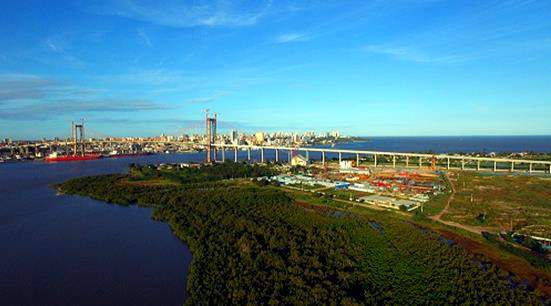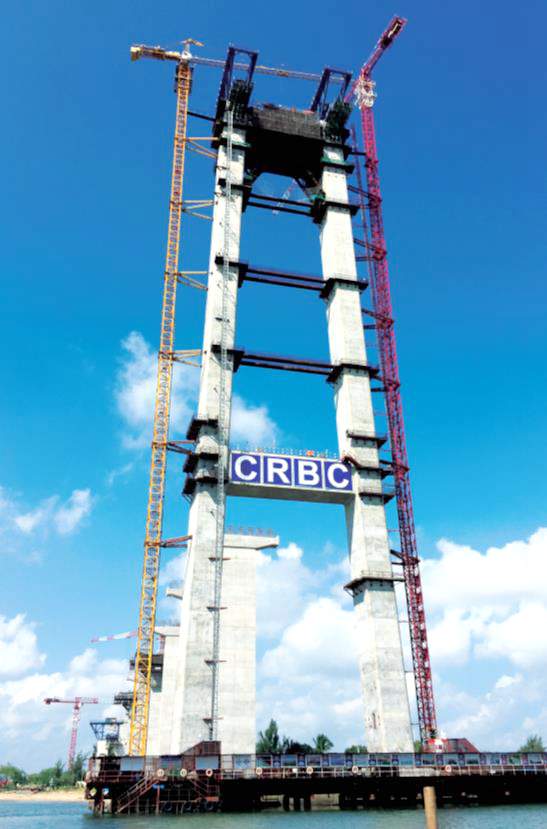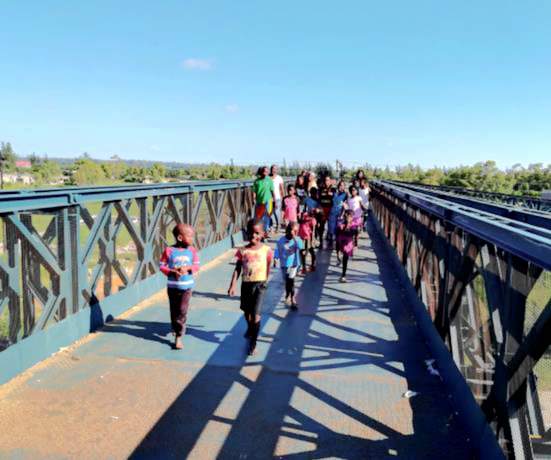The Dream Bridge on Maputo Bay
by Hu Yifeng
[Mozambique] Silva Magaria
It is morning and a sea breeze is murmuring through Maputo. A dapper Davari comes out of his new house in Katembe, a suburb in the Mozambican capital, starts his taxi and heads toward the city center. Soon he reaches the Maputo-Katembe Bridge, a suspension bridge across Maputo Bay, connecting the capital on the northern shore with Katembe on the southern bank.

Every time he comes here, Davari slows down to enjoy the scenery and also to cherish his personal link with the bridge. He was part of the construction team and for him, it is indeed a bridge of happiness.
An Old Driver's Mozambican Dream
When Davari was young, his family was extremely poor. They lived in a thatched hut in a village. His parents sold cassava flour on the roadside, a staple made by drying and grinding the root of the cassava plant. They earned about 2,000 meticais (USD30) a month, which went to feed their five children. When he grew up, Davari went to South Africa to try to make money as a migrant worker, refusing to stay in abject poverty. But he was a stranger in a foreign country and couldn't make his fortune. Even after nearly five years, his life did not improve.
When the Maputo Bay Bridge began to be built, Davari went there looking for work and was hired as a driver. Since he was older than most of his co-workers, they affectionately called him the "Old Driver". He was diligent and a good learner and his income went up steadily. He began to save money. The project paid him an average monthly salary of 18,000 meticais (USD273) and even after expenses, he could save nearly 8,500 meticais (USD129) every month. In a year, he had put by nearly 100,000 meticais (USD1,515).
Prosperity had finally arrived and his social status further improved due to his identity as the employee of a foreign company. The next step was to build his own house, marry a beautiful woman and start a family. He and his wife Santa Rosita have two children now. "It changed my life," Davai said emotionally, talking of the sea change in his life. "After the Chinese company came, our lives have improved dramatically!"
Like Davari, many other locals have benefited from the bridge project, which provided local jobs. At the peak of construction, more than 3,700 locals were employed, working in different construction or management positions. The project department provided regular training to improve the employees' skills. It trained a large number of technicians and gave recommendations to the outstanding employees to help them find new jobs when the project was over.
Today, in the area where Davari lives, many people's lives have improved thanks to the project and many have their own house now. Like Davari, they have seen their dreams come true with hard work.
The Maputo Bay Bridge has laid the foundation for the development of Maputo. The bay divides the city into two parts. While the Maputo urban area on the north bank developed into an urban center with a population of more than 2 million, Katembe on the south bank had remained stagnant due to transport constraints.

The Maputo Bay Bridge
Although Maputo Bay is less than 700 m wide at its narrowest point, for many years, due to the lack of a bridge connecting the two banks, the local people had to spend nearly 90 minutes to cross from one side to the other by ferry. During peak traffic, it could take more than five hours, hindering commuters as well as the overall development of Maputo. The bay blocked economic exchanges between the two banks and created a huge gap in their development.
But since November 10, 2018, the scene has changed. The Maputo Bay Bridge and its link roads were officially opened to traffic on this day, which was also the 131th founding anniversary of Maputo, with a grand ceremony in the capital to celebrate the two big events. The traditional song and dance and air shows were attended by Mozambican President Filipe Jacinto Nyusi, Mozambican and Chinese officials, and more than 3,000 local people. They admired the bridge – the longest suspension bridge in Africa, calling it magnificent from the bottom of their heart.
The bridge has facilitated the expansion of Maputo's urban space and accelerated Katembe's urbanization. The Mozambican government's detailed plans for Katembe's urbanization envision building a new city with an area of about 2,000 hectares in the suburb, which will be home to at least 400,000 people. With the focus on developing industry, logistics, tourism, business and residential areas, Maputo residents have bright prospects ahead.
Fruitful Multi-Party Cooperation
"I hope to work in China, building bridges," Dean, a South African engineer who worked on the bridge, told the Chinese engineers after the project was completed.
Dean said he had worked together with Chinese engineers for more than four years and admired their skill. He also found them pragmatic in work. Their goal was completing the project efficiently and with high quality and they never discriminated against any nationality or race.
"This is true craftsman spirit and the spirit of science," Dean said. All this has made him keen to go to China and acquire bridge construction experience there.
There were many non-Mozambican engineers like Dean in the project team. Although the Maputo Bay Bridge is the fruit of cooperation between China and Mozambique, it absorbed the technical strength of other countries as well and was a model of multilateral cooperation.
However, things were not so smooth in the initial stage, when there were differences in opinion among the different participants.
The Chinese team gave importance to technical experience in engineering while the state-owned Mozambican company that promoted and managed the construction and its consulting team paid more attention to theoretical calculations. Sometimes the two sides would argue over a single issue for a whole day without reaching an agreement.
To solve this problem, the project department hired internationally renowned quality monitoring and design consulting firm GAUFF of Germany and the famous supervision company in southern Africa, CPG, as project quality safety monitoring and design consulting service providers, turning the project into an entire industrial chain integrating international engineering, procurement and construction engineering design, construction, purchasing, monitoring, consulting and management. It also invited several third-party testing companies such as Hong Kong infrastructure consulting company AECOM, South African pile foundation inspection company Geosure, and Wuhan Guojian Testing Technology Co. Ltd. Of China to perform strict product quality control.

The main tower under construction
While the international team effectively guaranteed the construction quality of the bridge, the differences, however, persisted.
In this multi-party cooperation, the participants continued to argue because they had different understanding of the details. For example, the Chinese engineers and German supervisors once argued on what should be the right length of the steel strands to be used in the concrete girders. Although the difference in the two lengths the two sides insisted on was as little as 3 cm, neither deemed it an insignificant detail. Several checks and a lot of communication later, the difference was finally addressed. It indicated the project team's craftsman spirit, which valued construction quality and strove for excellence.
Having been working in the field of engineering materials for more than 30 years, Dean has a lot of experience and knows this very well.
He was responsible for the supervision of engineering materials in the Maputo Bay Bridge project where his greatest concern was ensuring the structure's durability and resistance to corrosion. Under his supervision, all the work, from ensuring the right ratio of the material mixture for the concrete, prefabrication, on-site pouring of the concrete to on-site steel structure processing and assembly was carried out methodically.
The concrete structure of the bridge followed both Chinese and European design standards, and adopted the most stringent design to ensure the thickness of the anti-corrosion protective layer. The project department collaborated with research institutions to conduct adequate survey and experiments on local concrete raw materials, and creatively completed the application of high-performance concrete. The excellent quality of the concrete and steel structures has won recognition from many quarters.
The Maputo Bay Bridge won the Concrete Society of Southern Africa's Fulton Award, southern Africa's most prestigious concrete accolade, in 2017 for using concrete of the highest quality, and again in 2019 for its advanced construction management technologies and excellent concrete construction quality.
Protecting Future Generations
The Maputo Circular Road in the capital is a bustling road, full of high-speed traffic. The traffic used to be especially nerve-racking for the schoolchildren attending the Chiango Primary School by the road. In 2018, Zuma, a resident of Maputo, lost her daughter due to the traffic. The child was hit by a car while crossing the road to go to school. The mother's anguished cries triggered protests by the crowd that had gathered. They blocked the road an for some time, the accident continued to dominate the television and newspapers, especially as there were concerns about more accidents in the future due to the absence of any pedestrian crossing near the school. Despite several consultations with the public, the municipal government couldn't fix the problem and finally sought help from the team building the Maputo Bay Bridge.
The project team promised to build a footbridge near the school within a month to ensure the safety of the schoolchildren and within hours had selected the site for the footbridge and completed its design. Construction started soon and a month later, the new steelframed footbridge stood over the road in front of the school.
More than a year after it was built, Zuma's youngest son was old enough to go to school. His mother has come out of her fear and no longer frets about his going to school because she says he has a guardian to look after him – the dark green footbridge built by the Chinese. It is special because it protects the lives of the children, who are the future of the country. The locals will always remember the team that built the bridge for them.

The footbridge, the protector of future generations
Mozambique was an important stop on the ancient Maritime Silk Road. In 1558, a merchant ship laden with Chinese porcelain items docked here. People in Mozambique continue to use porcelain to this day. Besides the heritage of the ancient Maritime Silk Road, the modern era's 21st Century Maritime Silk Road, the sea route of the Belt and Road Initiative, is bringing in new benefits. The construction of the Maputo Bay Bridge has ensured that the traditional friendship between the people of China and Mozambique is inherited by the modern generations and will be carried forward. In the future, there will be more such successful cooperation projects that will bridge the barriers caused by the Pacific and the Indian Ocean, making the friendship between China and Mozambique increasingly stronger.
FOR MORE
Project Overview:
To the north, the Maputo Bay Bridge connects several municipal roads in the urban area of Maputo. To the south, it leads to Mozambique's border with South Africa some 110 km away. The bridge was built by China Road and Bridge Corporation.
The single-span gravity-anchored suspension bridge has a main span of 680 m. Its twin towers in the north and south are each 141.2 m high. It is the longest suspension bridge in Africa. The north approach span is 1.09 km long; the upper structure consists of precast concrete T-beams and continuous rigid-frame concrete box girders. The south approach span is 1.23 km long; the superstructure is composed of prefabricated T-beams and the total length of the main approach span is 3.01 km.
The Maputo Bay Bridge project won American engineering and construction news provider Engineering News-Record's Award of Merit in the Global Best Projects 2019 category for its excellent construction quality, good international cooperation, scientific safety management, innovative structural design and contribution to infrastructure building in the coastal areas of southern Africa.


